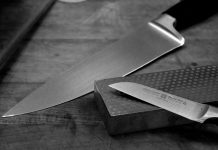However, street fighting techniques aren’t all about how to throw a punch; taking a punch is just as important. If you follow the steps in this article, you’ll have a much better chance at surviving even the most brutal fights.
Awareness
Naturally, your chances at walking out of a fight with the upper-hand increase if you’re alert when the first blow is dealt. Now, we can’t always know when someone’s about to hit us. If we could; life would be so much easier. There are going to be times when you’re blind-sided (hit without expecting it). If that ends up being the case, skip this step and move on to the next.
Maj. Gen. James Mattis once said: “Be polite, be professional, but have a plan to kill everybody you meet.” He couldn’t have been more correct, being alert at all times greatly increases your chances of survival in case of a street fight.
Whether you’re in a crowded place, or simply in a heated discussion with another person, you need to think worst case scenario. If you have already accepted that you may have to resort to violence, you’ll find that your “pre-fight jitters” aren’t as overwhelming as they usually are.
Look for the signs of aggression, if your potential opponent has his (or her) fists clenched, that’s a good sign that they’re getting ready to throw a punch (don’t worry, we’ll get into how to take a punch later).
Always be aware of their hands, not just because of clenched fists, but also hands are what hold weapons. If your opponent has a weapon and you don’t, try to avoid confrontation as much as possible.
De-escalation
Why waste your time fighting if you don’t have to? Most potential fights can be resolved without conflict, with just words. A great book to read in regards to de-escalating situations is called “Verbal Judo” by George J. Thompson and Jerry B. Jenkins. Most law enforcement officers are given this book in the police academy to study the art of persuasion. This book describes different techniques you can store in your mental arsenal to diffuse potentially hostile situations.
Humor is a universal language of peace. If you can, try to resort to it, but don’t humiliate your opponent. Humiliating your opponent will almost always result in a fight, so use humor in other ways. If there is a group of people, de-escalation is your safest bet. There’s nothing wrong with living to fight another day, so if the odds aren’t in your favor, do your best to diffuse the situation.
Distraction
You’ve tried de-escalating your situation with no luck, so now we get down to business. Legally, you have a better chance of getting away with a fight if you claim self-defense. You can’t claim self-defense, however, if you sucker-punch your opponent just because he gave you a dirty look. If they have a weapon though, that’s a different story. Tip – if you carry a baseball bat in your vehicle for self-defense; put a baseball glove in the same compartment with it, your lawyer will thank you.
Distraction techniques come in two categories: verbal and physical. First, we’ll go over verbal distraction, as it’s the easiest technique to accomplish. A lot of times, the first thing that comes to mind when people think of a verbal distraction is the classic “look, over there!”. A great verbal distraction technique is yelling as loud as you possibly can before you attack. Sounds stupid, right? Well if it’s stupid and it works, it’s not stupid.
Physical distraction is the most effective technique if done correctly. The three best points to strike your opponent to distract them are the throat, between the hip and the knee, and the front part of the shin. These three areas are the most easily accessible, and painful areas on the body to strike. Use caution when striking the throat, however, because it only takes between 5-20lbs of pressure (depending on age, and gender) to crush a person’s trachea. The average force exerted in a middle-aged man’s punch is 170-450lbs of pressure, so you can see where this could land you with a murder case because of a fight.
Technique
Learning any martial-art will greatly increase your chances of surviving a street fight. Some martial arts are more realistic for real-world scenarios; while others are frankly…art. The three best martial arts to learn that translate well to the real world are Karate, Jiu-Jitsu, and Krav Maga. Before you get offended that Taekwondo isn’t a part of this list, remember this is an article to prepare you for a street fight, not a debate class.
Karate is a great fit for street fighting because it utilizes a strict technique that allows you to strike your opponent with lethal accuracy and discipline. Karate uses kicks, punches, some elbow strikes, and throws. One of the most well-known UFC fighters, Georges St-Pierre, has a Karate background. To become efficient in Karate, however, you need to dedicate years of practice. If you’re looking for a more short-term solution, this may not be the best suit for you.
Jiu-Jitsu studies mostly grappling techniques, making it a highly recommended martial art to study. Most street fights end up on the ground, so knowing your way around your opponent makes your chances of walking out on top skyrocket. While it may take a while to rank up in Jiu-Jitsu, a white belt who’s been studying for a few months has the upper-hand over an inexperienced fighter.
The best martial-art to study for when you get surprised with a street fight is Krav Maga. This martial art is all about speed; and violence of action. These two traits are critical to winning a street fight if you can’t overpower your opponent, you can beat them with speed. Krav Maga is a very difficult martial-art, so make sure you do some cardio on the side before you sign up.
Taking a punch (blocking)
Being on the receiving end of a punch to the face isn’t as bad as you may think. Yes, it hurts, but it’s not the end of the world. There are ways to reduce the impact you’ll feel from a punch, and if you follow them, it’ll help you stay in the fight. Everyone is made differently, so expect your opponent to be able to take more hits than you can. Never underestimate your opponent, expect them to be tougher than they might actually be, otherwise, you could find yourself out of the fight sooner than you expected.
Blocking punches is one way to reduce the effect you feel from a hit, but you need to be careful, blocking too much will give your opponent the momentum they need to finish the fight in their favor. Blocking should only be used to catch your breath, or to set up for a counter-punch. To block, simply place your forearms between your face, and the attack. While there are multiple techniques for blocking, this is the simplest.
A good tip to remember for blocking is that you should never stay in a blocking position for more than 3 strikes. If you do, you risk your attacker gaining momentum. Instead, after an opportunity arises, throw a counter punch. If you don’t know much about fighting, we’ll get into throwing a punch later. Laying on the ground and curling your legs to your chest while covering your face is not a block, and should only be used to protect your life from multiple attackers.
Taking a punch (slipping)
A term us fighters use is “slip; and rip”, and it refers to moving your head away from an attack, and throwing a counter punch. This is the most effective way to win a fight because if your opponent can’t hit you, they can’t hurt you. To slip a punch (or any strike), simply side-step to your opponent’s weak hand side, and move your head slightly to avoid the strike. Try to avoid retreating to the rear, because your opponent will just chase you and gain momentum. While slipping strikes, always keep your guard up, and your chin down.
Never look away from your opponent, ever. If you need to duck down to avoid a strike, keep your guard up, head up, and simply squat. Moving your head down sets you up for a knee to the face, or an uppercut, both of which are incredibly painful to receive. Whenever you slip your opponent’s strike, always follow up with a counter. If you’re too far from your opponent, a simple leg-kick is very effective to close the distance while distracting your opponent with pain, setting up your finishing strike to the face.
Taking a punch (the old-fashioned way)
Sometimes you’re unable to slip or block your opponent’s strike. This leaves us with our last option, taking the hit. Don’t get too nervous, panicking will ruin your focus and give your opponent the upper hand. Odds are, your opponent doesn’t like getting hit just as much as you don’t. If you must take a hit to the face, you’ll be fine, your skull is built for taking trauma.
What you need to be conscious about, however, is your jaw. Your jaw can easily be broken with a hard enough hit, so try to avoid taking too many hits in a row. Your nose can also be broken, or dislocated (painful, however, most of the time harmless), but that’s a risk every fighter must take. Don’t be too scared about the “what if’s”, you’re not in a fight to look pretty, you’re in a fight to survive.
Getting “knocked out” is very common in fights. The most common reason is that the nerve cluster located behind the jaw bone becomes agitated and shuts signals down to your brain temporarily. Most of the time; it’s just a superficial injury, and you’ll recover without any issues. If you find yourself suffering from short-term memory loss, or severe headaches, seek medical help immediately (you may have a concussion).
Throwing a strike (Punch)
Everyone knows how to hit something, but not everyone knows how to properly throw a punch without hurting themselves. Ideally, only the first two knuckles should hit your target when you throw a punch. These two knuckles are the hardest knuckles in your hand and can withstand multiple blows before breaking. Avoid hitting your opponent with your pinky knuckle, because it’s very fragile, and will more than likely break upon impact.
When you make a fist, never secure your thumb inside your fist, you will dislocate your thumb. Instead, curl your thumb under your index finger, this will further protect your thumb from trauma. If the fight goes on longer than expected, you can also strike your opponent with the same knuckles that you use to knock on a door. While this technique is less effective than the traditional punch, it’s still effective at disorienting your opponent.
The best places to throw a punch at your opponent are the nose or the jaw. Fighters usually reference the area of the jaw right below the mouth as “the button”. It’s more or less a sweet spot to punch because it pushes the jaw back, and irritates the nerve clusters located behind the jaw, resulting in a knockout. Another great place to throw a punch is the chest. Punching the chest pushes your opponent back, creating space between you both so you can use your reach advantage (if you have it).
Throwing a strike (Kick)
Incorporating kicks in a fight is a very important rule to follow. Most inexperienced fighters don’t anticipate kicks, so when you throw one, it catches them off balance and gives you the upper hand. If you don’t have the flexibility to reach your opponent’s face with a kick (which most people don’t), a simple leg-kick is quite effective if it lands in the proper area.
The best area to kick your opponent in the leg is between the hip and the knee. There is a soft area in the quad muscle that, if hit, will cause extreme pain and even cramping in your opponent. Another area you can kick in the shin bone (you’ll want to use the bottom of your foot for that one, not your toes), which has the same effect if you put enough force behind it. The last-resort area to strike on your opponent’s leg is their knee. While very effective, you should only do this if it’s life or death, as you can cause a long-lasting injury to them.
When throwing most kicks, especially to the leg, you’ll want to land your kick with the top of your foot (between your toe knuckles, and your ankle). These kicks come from the side. If you initiate a push-kick (front kick), you’ll want to land your kick with the ball of your foot (the hard spot at the bottom of your big toe on the bottom of your foot). Front kicks are effective when struck in the groin, or chest area.
Worst case scenario
There are two “worst case scenario” situations you need to pay attention to when it comes to street fights. The first one is if your opponent has a weapon, whether it be a gun, knife, or a blunt object. The second being if there are multiple opponents. Both are equally dangerous, so if you want to increase your chances of survival, pay attention.
If your opponent has a weapon, your chances of surviving this fight have gone so low, it’s almost impossible. Don’t worry, there are ways out of this situation. If your opponent has a gun, and you have no experience in a martial art, your best survival technique is compliance. Do what they want you to do, don’t argue, and don’t make yourself a threat to them. Make yourself seem more personable, talk about your kids, wife, family. The more you make yourself seem like a person than a target to your opponent, the more likely they are to not harm you.
If your opponent has a knife or a blunt object, and you still wish to fight, you still have a chance. Take the fight to the ground, safely. Once you’re on the ground, control the arm that has the weapon and either take it from them or throws it a good distance away so it can’t be taken back by your opponent. When you are attempting to take your opponent to the ground, make sure you control the arm that has the weapon, otherwise, you expose yourself to injury while you’re not looking.
If there are multiple attackers, and you’re feeling confident enough to fight, there’s still a chance for you. Take out their leader first if you can, his friends are more likely to be hesitant to attack you if you took their leader out of the picture, as they don’t want to get hurt either. If you can’t take out their leader without it becoming a long fight, start taking out his friends starting with the weakest one. The fewer people in the fight, the better your chances.
Wrap-Up
There are multiple factors that surround street fights, but the ones in this article tend to be the most common. We highly suggest beginning to study one of the martial arts that are listed above, no amount of reading can prepare you fully for a fight like hands-on learning can. Remember, never start a fight unless you absolutely must, and always keep a focused mind. An angry mind is an unfocused mind, so never fight angry.





















